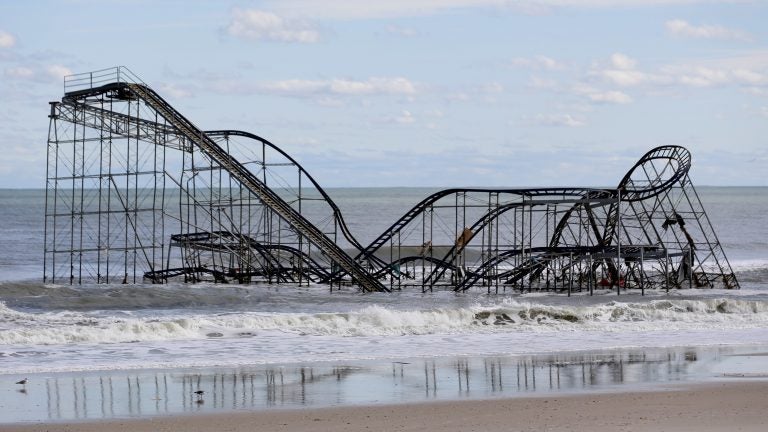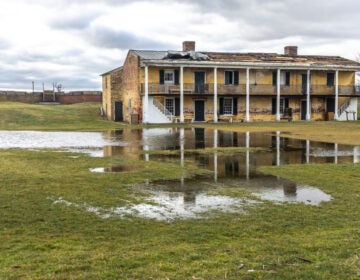Climate change’s impact on Hurricane Sandy has a price: $8 billion

A rollercoaster that once sat on the Funtown Pier in Seaside Heights, N.J., rests in the ocean on Wednesday, Oct. 31, 2012 after the pier was washed away by superstorm Sandy. (Julio Cortez/AP)
When Hurricane Sandy swept up the eastern seaboard in 2012, it left a trail of damage from Florida to Maine. Subways were inundated in New York City. Hurricane-force winds tore across New Jersey. Blizzard conditions walloped Appalachia.
The hurricane — also known as Superstorm Sandy — caused an estimated $70 billion in damages in the U.S., mostly from flooding. And while scientists have long believed that some of the carnage was attributable to a warming climate, it’s been unclear just how much of a role human-caused warming played in the storm’s impacts. New research, published Tuesday in the journal Nature Communications, puts a dollar amount on some of those damages and it’s a startling figure.
Using flood maps and sea-level rise measurements, researchers found that human-induced sea-level rise caused an estimated $8 billion in excess flooding damage during Hurricane Sandy and affected an additional 70,000 people.
“I often hear people say when we’re trying to help them adapt to increasing coastal flooding, ‘Well, it’s not going to happen in my lifetime, the sea-level rise won’t happen in my lifetime,'” said Philip Orton, a co-author of the study from the Stevens Institute of Technology in New Jersey. “But it’s already happening to people. It’s already here.”
Sea levels at the tip of Manhattan have risen about 8 inches since 1950, according to the National Oceanic and Atmospheric Administration. Estimates range for how much additional sea-level rise is likely to occur, but on average, the expectation is that by mid-century water levels could rise by more than a foot in New York City, compared to the year 2000.
In worst case scenarios, in which humanity does not significantly cut its climate-warming greenhouse gas emissions and the world’s ice sheets rapidly melt, sea levels could rise by more than 6 feet by the end of the century, putting hundreds of millions of people at risk worldwide.
Higher water levels mean more areas are susceptible to flooding, storm surge and other problems associated with hurricanes, as well as more chronic flooding from high tides.
The Biden administration has made addressing climate change one of its top priorities. It’s proposed a major reconfiguration of the nation’s energy and transportation sectors to cut the country’s outsized contribution to global warming, with the goal of making the U.S. carbon neutral by the year 2050. Accomplishing that feat will require major federal investments and likely bipartisan support. It’s unclear if the administration will be able to procure the latter.
The new study, which joins a growing body of broader attribution science, aims to quantify the cost of inaction and business as usual. Similar studies found that climate change fueled the strength of Hurricane Harvey, increased the risk of Australia’s recent unprecedented fire season and contributed to a record-breaking heatwave in Europe.
Scientists have debated whether Hurricane Sandy was made more intense by a warming climate, but it’s difficult to know. Generally, there’s agreement in the scientific community that hotter global temperatures and warmer ocean waters will lead to more rapid intensification of hurricanes.
Quantifying exactly how much those climatic differences affected a storm like Sandy is difficult. That’s why Orton and the team of researchers focused their efforts on sea-level rise, where there’s a bevvy of good data. They used that data to model the impacts of Hurricane Sandy in a world without climate change and found the estimated $8 billion difference.
“Increasingly we have the tools to simulate these events and study and quantify the impact of climate change on people’s lives,” Orton said. “People’s lives were dramatically changed by Hurricane Sandy and a lot of them don’t realize it had to do with climate change at all.”
9(MDAzMzI1ODY3MDEyMzkzOTE3NjIxNDg3MQ001))




